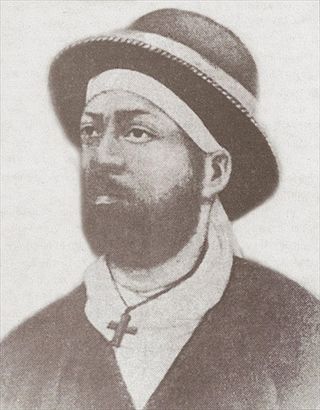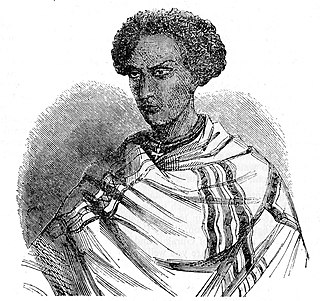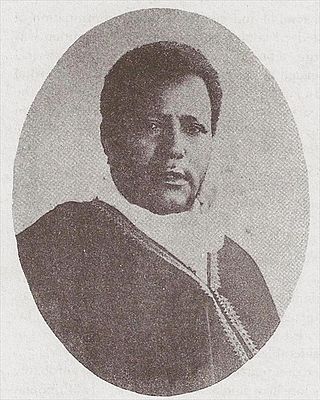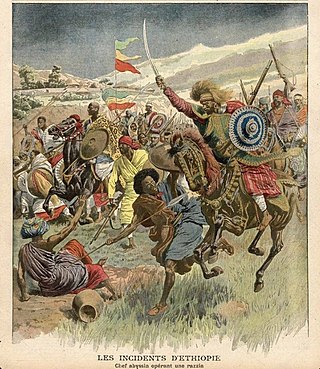
Menelik II, baptised as Sahle Maryam was king of Shewa from 1866 to 1889 and Emperor of Ethiopia from 1889 to his death in 1913. At the height of his internal power and external prestige, the process of territorial expansion and creation of the modern empire-state was largely completed by 1898.

RasMakonnen Wolde Mikael Wolde Melekot, or simply Ras Makonnen, also known as Abba Qagnew, was an Ethiopian royal from Shewa, a military leader, the governor of Harar, and the father of future Emperor Haile Selassie. Described by Nikolai Gumilev as “one of the greatest leaders of Abyssinia”, he served in the First Italo-Ethiopian War, playing a key role at the Battle of Adwa.

Shewa, formerly romanized as Shua, Shoa, Showa, Shuwa, is a historical region of Ethiopia which was formerly an autonomous kingdom within the Ethiopian Empire. The modern Ethiopian capital Addis Ababa is located at its center.
Ankober, formerly known as Ankobar, is a town in central Ethiopia. Located in the North Shewa Zone of the Amhara Region, it's perched on the eastern escarpment of the Ethiopian Highlands at an elevation of about 2,465 meters (8,100 ft). It is 40 kilometers (25 mi) to the east of Debre Birhan and about 90 miles (140 km) northeast of Addis Ababa.

Hailemelekot Sahle Selassie was Negus of Shewa, a historical region of Ethiopia, from 12 October 1847 until his death. He was the oldest son of Negus Sahle Selassie an important Amhara noblemen and his wife Woizero Bezabish Wolde.
Nagasi Krestos was the ruling prince of Shewa, an important Amhara noble of Ethiopia. Nagasi succeeded to unite fragmented Amhara districts in Shewa, and launched several wars of reconquest of Shewan territories against his Oromo enemies.

Sahle Selassie was the King of Shewa from 1813 to 1847. An important Amhara noble of Ethiopia, he was a younger son of Wossen Seged. Sahle Selassie was the father of numerous sons, among them Haile Melekot, Haile Mikael, Seyfe Sahle Selassie, Amarkegne and Darge Sahle Selassie; his daughters included Tenagnework, Ayahilush, Wossenyelesh, Birkinesh, and Tinfelesh. He was the great grandfather of Haile Selassie, the last Emperor of Ethiopia

Darge Sahle Selassie, Horse name Abba Gersa, was a 19th-century Ethiopian nobleman, provincial governor, general and a trusted councillor of his nephew Emperor Menelik II.

The Battle of Embabo was fought 6 June 1882, between the Shewan forces of Negus Menelik and the Gojjame forces of Negus Tekle Haymanot. The forces fought to gain control over the Oromo areas south of the Gibe River. The Gojjame forces under Tekle Haymanot were defeated. This is one of the three battles which Donald Donham lists that led to Shewan supremacy over the rest of Ethiopia.
RasGobena Dache was an Ethiopian military commander under Menelik II and during his reign. An ethnic Oromo, he is known for campaigning against Oromo territory to incorporate more lands into the Ethiopian Empire in the late 19th century.

Tekle Haymanot Tesema, also known as Adal Tesema, Tekle Haymanot of Gojjam, and Tekle Haimanot of Gojjam, was King of Gojjam. He later was an army commander and a member of the nobility of the Ethiopian Empire.

FitawrariHabte Giyorgis Dinagde also known by his horse name Abba Mechal was an Ethiopian military commander and government official who, among several other posts, served as President of the Council of Ministers and as Minister of War during the reigns of Menelik II, Zewditu and Haile Selassie. He was also Shum or Governor of Borena, Ibat, and Mecha.

Arsi Oromo is an ethnic Oromo branch, inhabiting the Arsi, West Arsi and Bale Zones of the Oromia Region of Ethiopia, as well as in the Adami Tullu and Jido Kombolcha woreda of East Shewa Zone.The Arsi are made up of the Sikkoo-Mandoo branch of Barento Oromo. The Arsi in all zones speaks Oromo share the same culture, traditions and identity with other subgroup Oromo.
A neftenya was the name given to Emperor Menelik II's warriors, who were primarily of Shewan Amhara origin, that collected customs and taxes for the Imperial Ethiopian government. In its literal meaning, neftenya, referred to riflemen in the Imperial Ethiopian Army who were known to have settled in Ethiopia's peripheral regions, including parts of present-day Oromia Region, the SNNPR Region, Gambela Region and the Benishangul-Gumuz Region from the late 19th century onwards. The origin of this term lies from the fact that these soldiers, i.e. "neftenya", were granted land on these newly conquered territories, including the services of the indigenous people on these lands, as rewards for their services.

Menelik's conquests, also known as the Agar Maqnat, were a series of expansionist wars and conquests carried out by Emperor Menelik II of Shewa to expand the Ethiopian Empire.
Bafena Wolde Mikael or beter known as just Bafena (1834-1887) was the second wife of Menelik II then the King of Shewa. She was described as ‘‘attractive, vivacious and ambitious’’ and is remembered for her failed conspiracy against her husband, in a attempted coup plot in 1877.
Bashah Aboye horse name: Abba Däffar, was a distinguished Ethiopian military commander under Emperor Menelik II, and governor of several former principalities and regions in the south. Bashah died fighting the Italians during the Battle of Adwa.
Garmame and Horse name: Abba Mala was an influential 19th century Ethiopian military commander, provincial governor and royal counsellor serving under Negus Sahle Selassie, Haile Melekot and Emperor Menelik II. He held the title of Dejazmach. Garmame is remembered for his leading role in rescuing Menelik II and other notables from captivity in July 1865, and restoring the Shewan heir back to the throne. In May 1877 he prevented a coup concocted by Bafena, and solidified the position of his Negus. After retirement from military activities, Garmame governed large tracts of fertile land south of Ankober, and is also remembered for his role in providing relief to the people during the disastrous 1890's famine'.

Welde Giyorgis Aboye was one of the most prominent Ethiopian generals who spearheaded Emperor Menelik's southward expansion at the close of the 19th century. His fame soared after leading the conquest on the Kingdom of Kaffa as a Ras, and was subsequently appointed as provincial governor of that fief by the Emperor. Welde Giyorgis later became the governor of Begemder. A few months before his death, he was elevated to Negus, of Gondar by Empress Zewditu in 1917, as recognition for his role in deposing Lij Iyasu.
The Battle of Dodota, also known as the Battle of Doddota, was a military engagement fought on December 1883 between a force of Arsi Oromo led by Leenjiso Diga and Jatene Bultum and a Shewan force led by Negus (King) Menelik II. This was during Negus Menelik II's second campaign against the Arsi.












